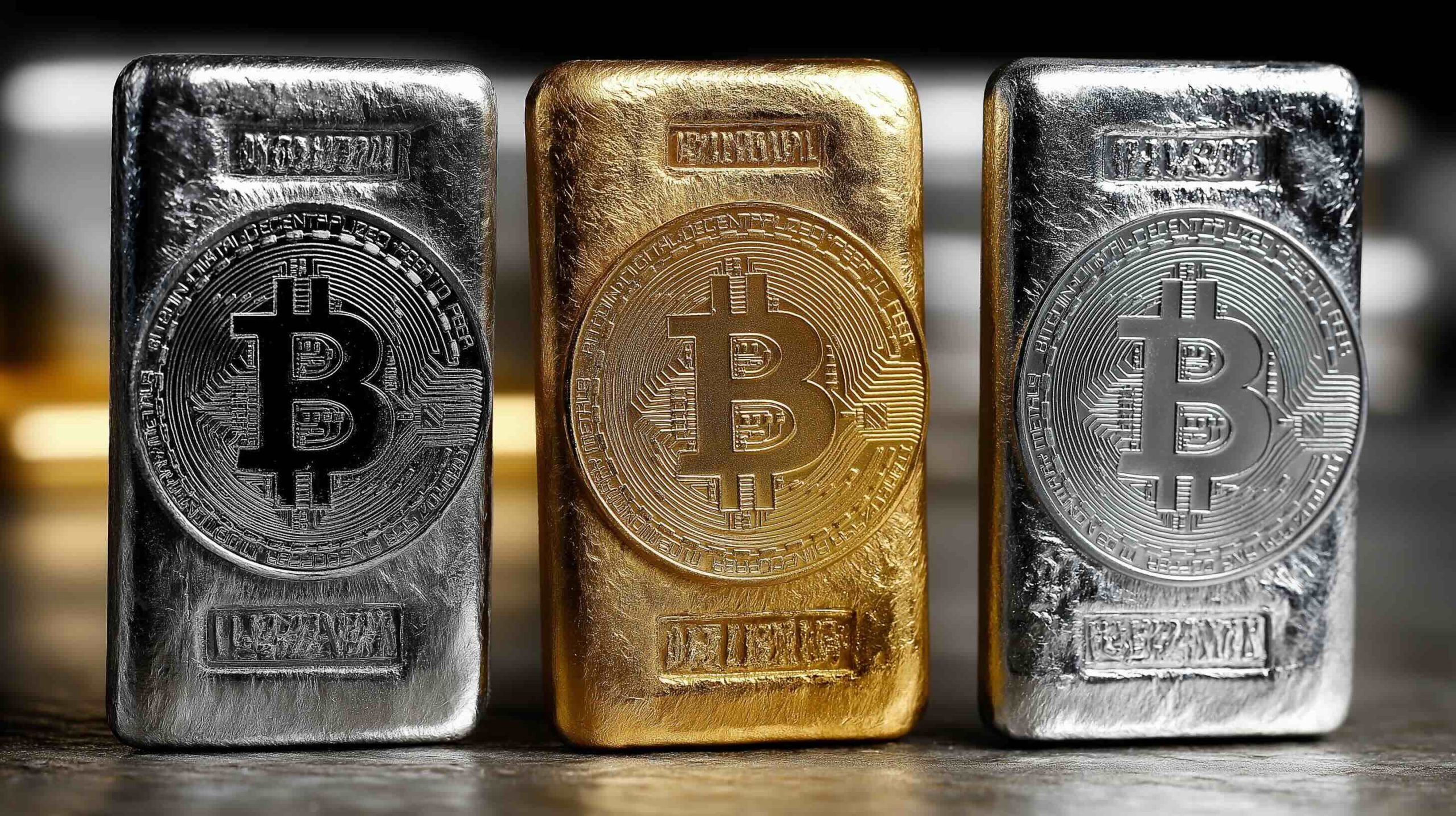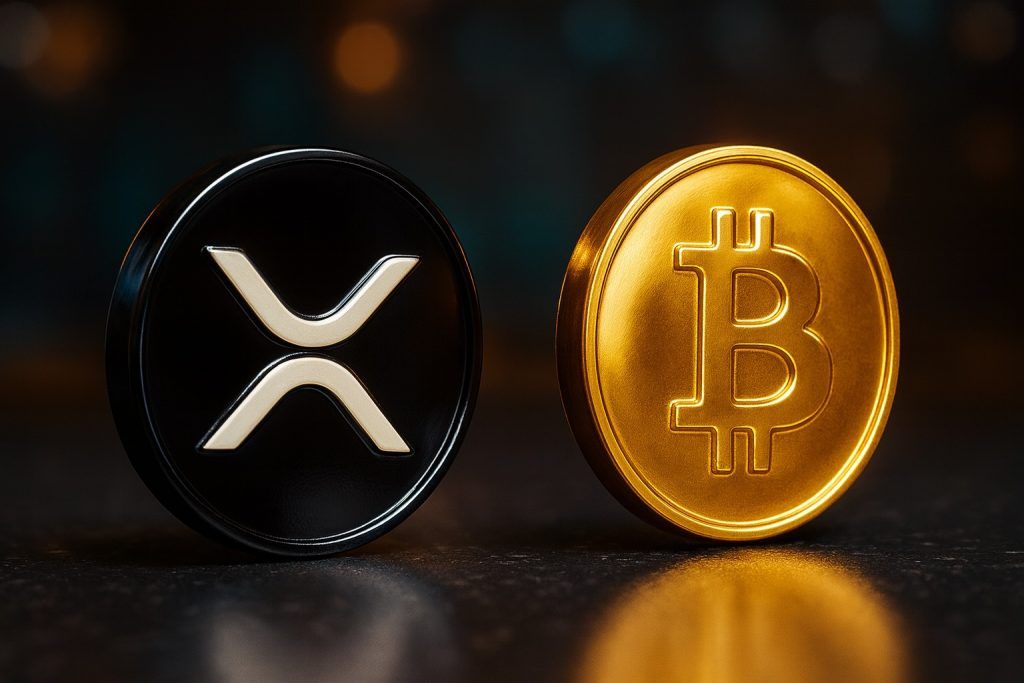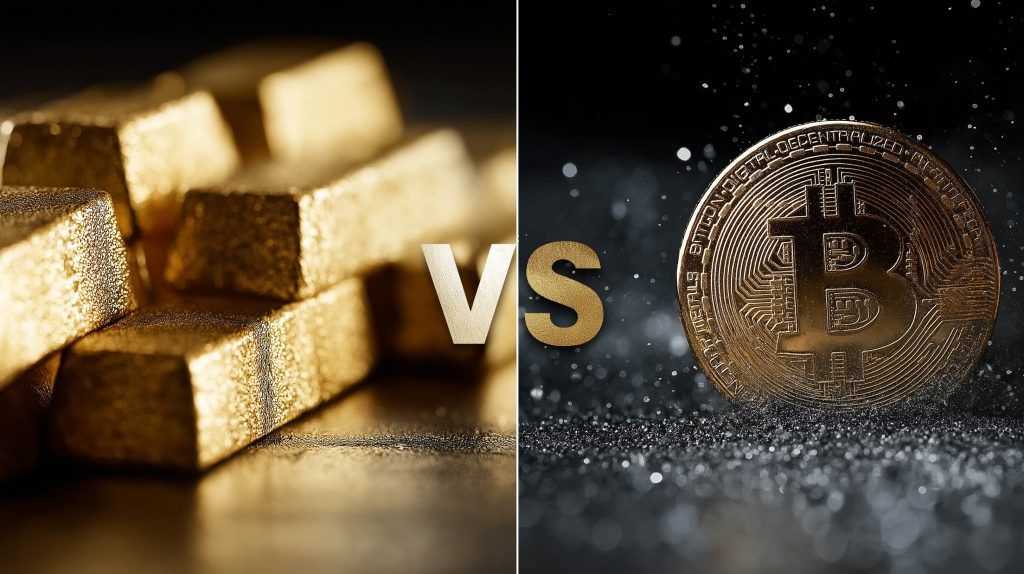- Record Highs: Both Bitcoin and gold hit all-time highs in early October 2025, with Bitcoin surpassing $125,000 per coin and gold breaking above $4,000/oz for the first time [1]. Silver also briefly traded above $50/oz – its highest level since 1980 – amid the rush to safety [2].
- Flight to Safety: Investors flocked to these assets as inflation stayed elevated, a U.S. government shutdown and geopolitical conflicts (from the Ukraine war to Middle East turmoil) stoked uncertainty, and the U.S. dollar weakened ~12% year-to-date [3]. This “safe-haven” scramble boosted both gold and its “digital gold”counterpart, Bitcoin [4].
- 2025 Performance: Precious metals have outpaced crypto so far in 2025. Silver is up roughly 70–75% year-to-date and gold about 50–53%, while Bitcoin’s volatile year has yielded around 30% gains [5] [6]. Over the long run, however, Bitcoin’s cumulative returns dwarf gold’s (48,000% vs 226% since 2011) – but with far greater volatility (Bitcoin’s ~52% annual volatility vs gold’s ~15%) [7].
- Big Money Inflows: Major institutions are driving the rally. Global central banks are on pace to buy ~1,000 metric tons of gold in 2025 – a fourth straight year of record accumulation [8] – and gold-backed ETFs have seen massive inflows. At the same time, cryptocurrency funds are attracting billions: over $3.2B poured into Bitcoin ETFs in just one week of early October (BlackRock’s new fund drew ~$1.8B) [9], and Ethereum funds saw about $1.5B of inflows as the first spot ETH ETFs launched [10].
- Bullish Forecasts vs. Caution: Many experts see further upside ahead. UBS predicts gold could reach ~$4,200 in coming months, and Goldman Sachs forecasts ~$4,900 by 2026 [11]. Crypto analysts likewise project Bitcoin climbing toward $130K–$160K by late 2025 (with some even eyeing ~$200K in 2026) [12], and a Standard Chartered unit expects Ethereum around $7,500 by end of 2025 [13]. However, not everyone is bullish: veteran investor Robert Kiyosaki warns that “bubbles are about to start busting,” predicting gold, silver, and Bitcoin could see a 50% crash before rebounding [14].
- Risk/Reward Profiles: Gold and silver are time-tested safe havens with lower volatility, whereas cryptocurrencies offer higher potential returns at the cost of extreme swings. In a recent market panic, gold actually rose 1.5% (back above $4,000) as the go-to refuge, while Bitcoin plunged ~10% intraday [15] [16]. Crypto’s history includes multiple 70–80% drawdowns, compared to gold’s more modest pullbacks (usually under 30%) [17], underscoring the trade-off between stability and growth.
Current Market Snapshot (Oct 2025)
As of mid-October 2025, both cryptocurrencies and precious metals are trading near historic highs after an extraordinary rally this year. Bitcoin – the leading cryptocurrency – spiked above $125,000 in early October, marking a new record high [18]. It has since pulled back slightly, hovering in the low $120K range [19]. Ethereum, the second-largest crypto, similarly surged to about $4,753 (within ~7% of its all-time peak around $4,946) before a sharp correction brought it back near $4,000 by October 10 [20].
In the precious metals camp, gold broke above $4,000 per ounce for the first time ever on October 8, 2025, peaking around $4,059–4,078/oz [21] [22]. After a mild pullback, gold prices have been holding close to the $4,000 level. Silver has exploded to roughly $50/oz, briefly touching multi-decade highs (~$51.22 at one point) in mid-October [23]. This puts silver within a few percent of its all-time record (~$49.50 from 2011), after starting the year in the low $30s [24]. By comparison, major stock indices (e.g. the S&P 500 up ~15% YTD) have lagged these haven assets’ gains [25], highlighting how exceptional 2025’s run has been.
Recent Market Developments and News
Early October 2025 saw an eruption of new highs for both crypto and metals, followed by jolts of volatility tied to global events. In the first week of October, Bitcoin and gold hit record levels simultaneously, driven by safe-haven buying. However, by October 9–10 the markets encountered whiplash from geopolitical news:
- Profit-Taking After Peaks: After gold’s surge past $4k and silver’s spike above $50, a wave of profit-taking set in. News of a ceasefire in the Israel–Hamas conflict helped ease some immediate war fears, prompting a slight cooldown in metals. Gold dipped back below $4,000 and silver slipped under $50 on October 9 [26]. Traders locking in gains and a brief strengthening of the U.S. dollar caused this pullback, which analysts characterized as a healthy breather rather than a bursting bubble [27].
- Tariff Bombshell Hits Crypto: The very next day, October 10, an unexpected U.S.–China trade escalation rattled the crypto market. Former President Donald Trump threatened a “100% tariff on all goods from China” starting Nov. 1, reigniting trade-war fears [28]. This surprise announcement sent risk assets into a tailspin. Bitcoin plunged from around $122K to about $114,000 within hours on Oct. 10, and continued falling overnight to as low as ~$104,000 in heavy selling [29]. Ethereum and other altcoins were hit even harder – Ether fell roughly 7% intraday (dropping under $4,100) and kept sliding to around $3,400, its weakest level in weeks [30]. Even large-cap altcoins like XRP saw extreme swings, crashing ~40% from ~$2.80 to ~$1.64 before bouncing back partway [31]. This sudden “crypto carnage” wiped out an estimated $20 billion in leveraged positions within 24 hours, marking one of the largest crypto liquidation events on record (bigger than even the March 2020 COVID crash) [32].
- Broader Market Reaction: Traditional markets also shuddered. Stocks, which had been at record highs, reversed sharply into the red on the tariff news (the Nasdaq fell ~3.6% and S&P 500 ~2.7% that week) [33]. Crypto-related equities like Coinbase and Robinhood sank ~5–6% in sympathy [34]. In contrast, classic safe havens reasserted themselves: gold quickly rebounded about +1.5%, climbing back above $4,000/oz as panicked investors sought shelter [35]. This divergence was telling – in that moment of crisis, gold, not Bitcoin, was the refuge of choice, underlining that crypto still behaves like a risk asset under severe stress.
Despite these gyrations, market sentiment stabilized by mid-October. The crypto pullback, while steep, came on the heels of a strong “Uptober” rally, and many see it as a necessary correction. Likewise, gold and silver’s slight retreats have not erased their dominant uptrends. The overarching narrative of late 2025 remains one of investors shifting into hard assetsamid an atmosphere of economic uncertainty, even as short-term news triggers jittery swings.
Why Are Investors Flocking to Crypto and Metals?
Multiple catalysts have created a “perfect storm” driving both cryptocurrencies and precious metals higher in 2025:
- High Inflation & Currency Fears: Inflation has stayed above central bank targets in many countries, eroding confidence in paper currency. Investors remember the 1970s stagflation, when gold soared over 2,000% as an inflation hedge [36]. Similarly, Bitcoin proponents pitch it as an inflation-resistant asset since its supply is capped by design. The U.S. Dollar Index’s steep slide (down ~12% to multi-decade lows in 2025) has validated these concerns about currency debasement, making hard assets like gold and Bitcoin more attractive stores of value. As one Reuters piece noted, “Faith in fiat currencies…takes another blow,” which has fed what JPMorgan analysts dub the “debasement trade” – moving money into assets that governments can’t dilute by printing.
- Geopolitical and Economic Uncertainty: Ongoing conflicts and political strife have turbocharged safe-haven demand. The wars in Ukraine and the Middle East, surging global debt levels, and U.S. political gridlock (including a brief government shutdown in October) have all put investors on edge [37]. Gold thrives during times of instability, and indeed its record run has been fueled by “a storm of economic and geopolitical risks,” according to analysts [38]. Even Bitcoin, traditionally seen as a speculative tech asset, has been behaving more like a safe haven this year. “What’s good for gold is also good for BTC,” noted analyst Noelle Acheson, citing how rising inflation and expectations of renewed money-printing have made Bitcoin appealing to the same crisis-weary investors [39]. Both assets have been rising in tandem since late September as global tensions mounted [40].
- Central Bank & Institutional Buying: A historic wave of institutional capital has flowed into these assets. Central banks have been purchasing gold at a record pace (diversifying reserves away from the dollar), creating a solid price floor. Officials are on track to accumulate about 1,000 tonnes of gold in 2025, marking four consecutive years of record gold buying [41] [42]. “Central banks are buying gold hand over fist,” as one report observed, providing a “strong foundation” under the gold price [43]. At the same time, Wall Street is embracing crypto in unprecedented ways. The launch of new spot Bitcoin and Ether ETFs in 2025 opened the floodgates for mainstream investment. In early October alone, Bitcoin funds saw over $3.2B in inflows, and Ether ETFs hauled in roughly $1.5B [44] [45]. Major institutions and even corporations are accumulating crypto directly; for instance, one Nasdaq-listed company disclosed it holds 2.83 million ETH (over 2% of all Ether) on its balance sheet [46]. These developments signal growing acceptance of crypto as a legitimate asset class, further fueling demand.
- Monetary Policy Tailwinds: The prospect of easier monetary policy has added fuel to both asset classes. Markets widely expect the U.S. Federal Reserve and other central banks to pivot to cutting interest rates after a year of tightening. Lower rates make non-yielding assets like gold more attractive (reducing the opportunity cost of holding them) [47]. As one commodities strategist put it, with rates headed down, “gold is more attractive…investors aren’t losing out on higher yields” by holding bullion [48]. For cryptocurrencies, looser monetary conditions tend to boost liquidity and risk appetite. Bitcoin’s autumn rally coincided with rising bets that the Fed would cut rates at its Oct. 29 meeting, which bolstered risk-on assets. Ethereum stands to benefit even more in a low-rate environment because holders can earn yield through staking (around 4–5% annually), making ETH akin to a high-yielding asset when bond yields fall [49] [50]. In short, the anticipation of monetary easing has given both gold and crypto a further push upward.
All these factors combined have created a rare scenario in which traditional safe havens and digital assets are climbing together. As one market strategist noted, Bitcoin’s surge came “just as gold and Japanese equities rallied” on political developments, showing Bitcoin now sharing the driver’s seat with traditional havens in global markets [51]. The key common thread is waning trust in the status quo – whether it’s concern about fiat currencies, government stability, or the financial system itself – which has led investors to seek out alternatives, be it shiny metal bars or cryptographic coins.
Expert Commentary on Crypto vs. Precious Metals
Financial experts and analysts have been weighing in on this unusual tandem rally, offering insights and warnings:
- Barometer of Anxiety: Some see the parallel surge of gold and Bitcoin as a signal of underlying fear in the markets. “Gold’s unbelievable rise signals ‘something bad is happening and we should be nervous’,” one analyst warned amid gold’s record run [52]. The idea is that investors don’t buy gold en masse when everything is rosy – they buy it as insurance against things going wrong. Indeed, as CBS News put it, gold’s climb “reflects growing unease” – people are buying gold “not because everything is great, but because they are hedging against things going wrong” [53].
- Digital Gold Thesis: Bitcoin’s behavior in 2025 has lent credence to the “digital gold” narrative. “The only time I buy BTC is when society loses faith in governments and banks,” quipped Jeff Dorman, CIO of Arca, highlighting that Bitcoin’s appeal tends to spike during moments of institutional mistrust [54]. This year’s events – from U.S. political gridlock to currency worries – have provided exactly those moments. Noelle Acheson similarly noted that Bitcoin is trading like a safe haven, stating “What’s good for gold is also good for BTC” now [55]. Still, the October volatility revealed that Bitcoin has not yet fully unseated gold in the flight-to-safety department. As crypto analyst Noelle Acheson and others pointed out, Bitcoin is increasingly seen as a store of value, but in sudden panics (like the tariff scare) gold’s entrenched safe-haven status prevails [56].
- Volatility and “Boom-Bust” Warnings: A number of experts caution that investors must brace for turbulence, especially with silver and crypto. “Silver can be wildly volatile, prone to boom-and-bust cycles more than gold,”one long-time market watcher reminded, noting that the last two times silver neared $50 (in 1980 and 2011) huge busts followed [57]. Crypto veterans echo that historical perspective for Bitcoin and Ethereum, which have seen multiple drawdowns exceeding 50% in past cycles. “All bets are off” if geopolitical or macro risks intensify, warned CoinDesk analysts after the recent tariff-driven crash, meaning a quick crypto recovery could be derailed by further shocks [58].
- Institutional Endorsement: On the bullish side, many seasoned investors are endorsing a role for these assets in portfolios. Billionaire hedge fund manager Ray Dalio has advocated holding up to 15% in gold to hedge against economic instability [59]. On the crypto front, the rapid uptake of Bitcoin ETFs by giants like BlackRock is seen as a vote of confidence. “Spot ETFs have seen over $1.3B in a week, signaling renewed conviction from institutional allocators,” noted Javier Rodriguez-Alarcón of XBTO, emphasizing that big money views the recent dip as a buying opportunity [60]. Additionally, regulatory developments have been relatively favorable in 2025 – for instance, the U.S. administration’s more crypto-friendly stance earlier in the year and the approval of ETFs have provided tailwinds [61]. These moves by governments and institutions are lending legitimacy to Bitcoin and Ethereum, gradually integrating them into the traditional financial system.
- “Epic” Showdown Perspectives: Commentators have dubbed 2025’s parallel rally an “epic safe-haven showdown” between gold and Bitcoin [62]. While gold bugs and crypto enthusiasts often tout their preferred asset as the ultimate hedge, this year has shown that both can thrive under the same conditions. “Bitcoin is back in the driver’s seat… alongside traditional havens,” one strategist observed, noting that it’s maturing into a store-of-value asset rather than a speculative bet [63]. At the same time, gold’s enduring role was on display when it immediately caught a bid during the October scare, reinforcing its reputation as the world’s safe-haven of last resort [64]. The consensus among many analysts is that diversifying into both crypto and precious metals – in measured proportions – may offer a potent one-two punch for hedging different kinds of risk.
In sum, experts acknowledge the remarkable gains and increased convergence of these asset classes, but they also consistently stress due caution. The mantra is to respect gold’s stability and Bitcoin’s growth potential, while never forgetting that their risk profiles differ greatly.
Performance and Volatility: A Comparative Look
From a pure performance standpoint, 2025 has been stellar for both crypto and precious metals – but the scale and volatility of their moves differ:
- Year-to-Date Returns: Gold and silver are having one of their best years in decades. Gold’s price is up over 50%in 2025, on track for its biggest annual jump since 1979 [65]. Silver’s rise is even more dramatic at around 70%+ year-to-date [66], dramatically outperforming not just gold but most major assets. Bitcoin, after a rollercoaster year, is up roughly 30% in 2025 [67] – a strong gain (beating equities and bonds), though trailing the metals’ surge. Ethereum has also notched solid gains (ETH hit a new all-time high in late August and remained up significantly on the year [68]), but like Bitcoin it lagged the heady percentage increases of silver.
- Long-Term Growth: Looking at a longer horizon, cryptocurrency’s upside dwarfs that of precious metals – at least historically. Over the past ~12–13 years (since 2011), Bitcoin’s price has skyrocketed an almost unfathomable 48,000%, vastly outperforming gold’s roughly 226% rise in the same period [69]. Early Bitcoin believers have seen life-changing returns, whereas gold’s appreciation, while significant, has been steady and far less explosive. Silver’s long-term performance has been more tepid as well (its price today, around $50, is roughly double what it was 15 years ago, despite big swings in between). This highlights crypto’s appeal for growth-oriented investors, versus metals’ role for wealth preservation. As one headline quipped, it’s the classic “tortoise vs hare” scenario – gold’s slow and steady climb versus Bitcoin’s meteoric (if erratic) ascent.
- Volatility and Drawdowns: Along with higher returns comes higher volatility for crypto. Gold is known for its relative stability – its day-to-day moves are usually small, and major drawdowns are infrequent. Gold’s annualized volatility is around 15%, and it typically sees pullbacks of less than 20–30% even in rough times [70]. Bitcoin, by contrast, experiences gut-wrenching swings. Its annual volatility is on the order of 50% or more [71], and crashes of 50%+ have occurred multiple times (e.g. the 2018 crypto winter, the 2021–2022 decline, etc.). Ethereum and smaller altcoins are even more volatile, often amplifying Bitcoin’s moves. The recent Oct 10 episode exemplified this: within 24 hours Bitcoin plunged ~15% peak-to-trough, Ethereum about 20%, and some altcoins 30–40%, whereas gold moved only a couple percent. Such swings are virtually unheard of in the gold market. As one veteran watcher noted about silver (which is more volatile than gold but still typically less so than crypto), “Silver can be wildly volatile, prone to boom-and-bust cycles more than gold” [72] – and the same could be said, magnified, about cryptocurrencies.
- Correlation to Market Stress: In terms of how they respond to market shocks, gold has a long reputation for moving opposite to risk assets in crises (rising when stocks fall, etc.), whereas Bitcoin’s correlation patterns have been more complex. For much of its life, Bitcoin traded more like a high-risk tech stock – falling when equities fell. In 2025 we’ve seen hints of a regime change, with Bitcoin occasionally rising alongside gold in times of fiat or political stress [73]. But the stark reaction to the tariff news (gold up, Bitcoin down) shows that crypto hasn’t fully decoupled from risk-on behavior [74]. This distinction is crucial for investors: if you seek something that will reliably buffer a portfolio when markets tank, gold (and to a degree, silver) has a more established track record in that role. Bitcoin might or might not perform likewise in the next crisis – it’s still proving itself.
In summary, cryptocurrencies offer a higher-risk, higher-reward profile: they can deliver much larger gains over time, but with stomach-churning volatility and deeper drawdowns. Precious metals, especially gold, offer a steadier ride and more predictability, at the cost of lower long-term returns. An investor’s choice between the two (or allocation to both) ultimately comes down to risk tolerance and investment horizon.
Inflation Hedge and Safe-Haven Value
A key reason investors hold gold or Bitcoin is to hedge against inflation and currency debasement, as well as to protect against tail-risk events. Here’s how the assets compare in that regard:
- Gold – The Classic Inflation Hedge: Gold has been considered a store of value for centuries, and a hedge against inflation and currency decline. In periods of high inflation or negative real interest rates, gold tends to shine. The current environment – lingering inflation pressures and expectations of rate cuts – is a textbook scenario where gold thrives [75] [76]. In 2025, with central banks signaling a softer stance, investors piled into gold as a safeguard against the diminishing purchasing power of fiat money. Moreover, central banks themselves, concerned about the dollar’s outlook, have been buying gold as an alternative reserve asset [77]. Gold’s surge this year thus reflects both public and official sector attempts to hedge inflation and financial instability. Its record price is in many ways a barometer of global anxiety [78].
- Silver – Hybrid of Hedge and Industrial Metal: Silver shares some of gold’s safe-haven qualities (it often rallies alongside gold during inflationary or crisis episodes), but it also has a strong industrial demand component. In 2025’s rally, silver’s gains outpaced gold’s, partly because industrial usage is booming (solar panels, electronics, electric vehicles, etc.) while supply remains constrained [79] [80]. This dual nature means silver can act as an inflation hedge but also benefits from economic trends (e.g. the green energy boom). The flip side is that silver’s price can be buffeted by manufacturing cycles; it’s not a pure safe haven. Still, in the current climate, silver is clearly being bid as a cheaper proxy for gold – often nicknamed the “poor man’s gold” – with the added kicker of tight supply dynamics [81]. Notably, silver hitting $50 is psychologically significant; if it were to break decisively to new highs, some believe its safe-haven allure plus a potential physical squeeze could trigger a wild spike higher [82]. That possibility underscores silver’s status as both an inflation hedge and a speculative play.
- Bitcoin – Digital Inflation Hedge or Risk Asset? Bitcoin’s advocates often liken it to “digital gold” precisely because it has a hard supply cap (only 21 million BTC will ever exist). In theory, that makes Bitcoin immune to the kind of dilution that fiat currencies suffer when central banks print money. There is evidence that this narrative is taking hold: for example, Bitcoin’s rally in late 2025 coincided with a weakening dollar and concerns over U.S. fiscal deficits. Investors worried about money printing and debt have indeed been moving into Bitcoin as a hedge. Standard Chartered analysts pointed out Bitcoin was rising in step with indicators of U.S. government credit risk – suggesting it’s viewed as a hedge against Washington’s dysfunction [83]. However, Bitcoin’s track record as an inflation hedge is short and not yet consistent. It boomed in 2020–21 when inflation expectations rose, but then crashed in 2022 even as inflation hit multi-decade highs, largely because of its speculative excesses and tightening monetary policy. So Bitcoin’s role as an inflation hedge seems to depend on the cause of inflation and market liquidity. In times of currency crisis or loss of faith in banks, Bitcoin does appear to get bid up (people in some inflation-hit countries have turned to crypto as a store of value). But in broad market selloffs, Bitcoin can still fall alongside stocks. In summary, Bitcoin is evolving into an inflation hedge/safe-haven asset, but it hasn’t fully shed its risk-asset skin. Its response to future inflation or crises may increasingly resemble gold’s, yet caution is warranted in assuming it will behave exactly like gold in every scenario.
- Real-World Tests: 2025 provided real-world tests of these hedging properties. For instance, when the U.S. government went into a partial shutdown in October and brinksmanship over debt took hold, both gold and Bitcoin jumped – a sign that each was being used as an alternative safety net amidst faith-shaking political dysfunction [84]. Conversely, when an acute external shock hit (Trump’s tariff threat), gold and the U.S. dollar immediately diverged from crypto: gold and the dollar rose (classic risk-off move) while Bitcoin and stocks sank [85]. This underscores that gold remains the more reliable chaos hedge, whereas Bitcoin’s role can be scenario-dependent. Geopolitical flashpoints (e.g. an escalation of war) almost reflexively boost gold. Bitcoin’s reaction might be positive if the crisis undermines trust in fiat, or negative if it sparks a liquidity crunch – making its safe-haven status a bit two-sided.
In conclusion, as hedges against inflation and turmoil, gold is the stalwart – a universally recognized asset to preserve wealth when paper money falters. Bitcoin is the upstart – with huge potential as a hedge (especially for younger investors or those facing capital controls), but still working to prove itself under all conditions. Many investors in 2025 have decided to hold both, seeing gold for stability and Bitcoin for upside and as a hedge against an even broader range of scenarios (including technological change and the future of finance).
Investment Outlook Through 2025 and Beyond
Looking ahead, analysts are divided on how these assets will perform into late 2025 and beyond, but most agree the story isn’t over. Here are some key trends and forecasts:
- Precious Metals – Further Upside Projected: Wall Street banks have been raising their gold and silver targets in light of 2025’s momentum. UBS analysts now see gold reaching about $4,200/oz in the coming months [86]. Goldman Sachs upgraded its forecast to $4,900 by late 2026, essentially expecting new highs to be continually notched [87]. On silver, HSBC’s commodities team says silver “stands on the cusp” of its old record and will likely surpass $50/oz in the near term [88]. They envision silver trading in a volatile $45–$53 range through year-end [89] – meaning basically around current levels with potential new highs. Some bullish voices go even further: if silver blows past $50 decisively, a few experts speculate it could ignite a “generational” spike toward $75 or even $100 if a physical supply squeeze takes hold [90]. That’s an extreme scenario, but it underscores the constructive outlook many have on metals. It’s worth noting that gold at $4k+ and silver near $50 are uncharted waters in modern times; volatility is expected, but no major bank is calling a top yet. In fact, Metals Focus (a research firm) suggested there’s “no catalyst for gold to meaningfully retrace at present” and sees a possible attempt at $5,000/oz if current macro factors persist into 2026 [91]. Such optimism is tempered by the caveat that if inflation rapidly cools or peace breaks out in major conflicts, some of the safe-haven demand could fade.
- Cryptocurrencies – Optimistic but Dependent on Macro: The crypto community is similarly optimistic, though with the usual wide range of targets. After the recent pullback, many analysts still forecast Bitcoin to resume climbing. Some see BTC revisiting the $130K area by later in Q4 and potentially hitting $150K+ by the end of 2025 [92]. Standard Chartered’s crypto research team even suggested Bitcoin could reach around $150K in 2025 under favorable conditions, and noted $100K is increasingly viewed as a baseline target rather than a stretch [93] [94]. Looking further out, very bullish prognostications exist (e.g. certain models or commentators who believe Bitcoin could approach ~$200K in 2026 if the cycle extends [95]). On the Ethereum side, forecasts also skew positive: apart from Standard Chartered’s call for ~$7,500 ETH by end-2025 [96], chart analysts like Fundstrat’s Mark Newton saw Ethereum hitting ~$5,500 in the near term (mid-October) and still eye $5K into year-end assuming the uptrend recovers [97] [98]. Some prominent traders have argued that Ethereum is poised to outperform Bitcoin in the coming months, potentially reaching new all-time highs above $5K if the market stabilizes [99].
- Beyond 2025, the visions get even bolder. For instance, one veteran crypto analyst nicknamed “Poseidon” envisions this cycle’s peak for ETH around $8,500 [100]. And Joseph Lubin, Ethereum’s co-founder, mused that as blockchain adoption grows, Ether’s price could even increase 100-fold from current levels in the long run [101]. (That would imply hundreds of thousands of dollars per ETH, a reflection of an extremely bullish belief in Ethereum becoming “the most powerful resource of decentralized trust”globally [102].) Such predictions are speculative, but they illustrate the high ceiling that crypto enthusiasts see if the technology revolution succeeds.
- Cautious Views and Risks: Not everyone expects a straight line upward. Some mainstream financial institutions urge more conservative expectations. For example, Citigroup recently set a year-end target of only $4,300 for ETH, suggesting Ethereum might already be near fair value after its rally [103]. Citi’s analysts warned that excitement over ETF launches and upgrades (like Ethereum’s upcoming tech improvements) could be mostly priced in, and that without fresh catalysts crypto might consolidate rather than continue ripping higher [104]. Similarly, if economic conditions deteriorate or new regulations hit, bearish scenarios come into play. Analysts noted that a severe recession or credit event could still drag Bitcoin and ETH down in the short run (one worst-case estimate had ETH potentially dipping below $2,000 if a deflationary shock hit) [105]. And of course, the ever-present regulatory wildcard hangs over crypto’s longer-term outlook – any aggressive moves by governments to restrict crypto could dampen those rosy forecasts. On the metals side, a big risk is that crises abate: if geopolitical tensions ease or inflation rapidly cools, gold’s safe-haven premium could deflate somewhat. Even without a fundamental shift, after such a steep run-up there’s the risk of corrections — one veteran (Robert Kiyosaki) expects that we could see gold, silver, and Bitcoin all pull back on the order of -50% in a major shake-out before climbing again [106]. While not a consensus view, it’s a reminder that markets often test investors’ resolve.
- Investment Trends: A notable trend likely to continue into 2026 is the growing institutionalization of crypto and the sustained demand from central banks for gold. If BlackRock’s Bitcoin ETF and similar products continue to attract capital, crypto prices may get a long-term tailwind from traditional fund flows that smooth out some volatility. Likewise, if central banks keep diversifying reserves (for instance, China and Russia buying gold to reduce dollar exposure), gold will enjoy a structural bid. We’re also seeing cross-over interest – some gold proponents are dipping toes into Bitcoin via ETFs, and some crypto investors are acknowledging the wisdom of holding gold as a hedge. This blending could mean the old “gold vs. Bitcoin” debate shifts to “gold and Bitcoin” in many portfolios. Silver’s outlook is more tied to industrial trends (like green tech demand) along with the investment narrative; it could continue to surprise to the upside if shortages persist.
Overall, through the end of 2025, the forecast leans positive for both crypto and precious metals, albeit with a recognition that the easy gains may have been made and volatility will remain high. The backdrop of high global debt, potential Fed easing, and geopolitical uncertainty that boosted these assets in 2025 is not resolved – if anything, those issues are front-and-center heading into 2026. As long as that’s the case, the case for owning hard assets (physical or digital) as a hedge remains compelling. But investors should be prepared for a bumpy ride and have a plan for if/when sentiment temporarily reverses.
Risks and Benefits of Investing in Crypto vs. Precious Metals
Finally, it’s worth summarizing the pros and cons of each asset class from an investment perspective:
Gold & Silver – Benefits: These precious metals are tangible, universally recognized stores of value with thousands of years of history as money. They tend to hold their value or appreciate during inflationary periods and times of crisis – offering portfolio insurance when stocks or currencies falter [107]. They also exhibit significantly lower volatility than crypto; gold in particular rarely sees the kind of steep crashes cryptos do, making it a relatively stable asset (gold’s worst downturns are on the order of 20%–30%, far gentler than Bitcoin’s typical swings) [108]. Additionally, the market for gold and silver is highly liquid worldwide, and their value isn’t dependent on any single issuer or technology. Central banks and institutional investors already support prices (central banks buy gold for reserves, and industry uses silver extensively), which can provide a long-term demand floor. In short, gold and silver serve as trusted safe havens and inflation hedges that can anchor a portfolio against uncertainty.
Gold & Silver – Risks: Despite their stability, precious metals are not risk-free. They do not generate cash flow or yield (holding gold doesn’t pay interest or dividends), so during periods of rising interest rates or strong economic growth, they can lag other investments. If the economic or geopolitical outlook improves, gold and silver prices can stagnate or drop as the urgency for a safe haven diminishes [109]. For example, if peace treaties or fiscal reforms emerge, some of the “fear premium” in gold could unwind (analysts note gold’s price could dip 5–10% on profit-taking or if bond yields rise sharply) [110]. There’s also the issue of storage and security – holding physical metal requires safekeeping. Silver, while offering higher upside in bull runs, carries more volatility and has a history of sharp boom-bust cycles [111]. Its dual role means it could underperform if industrial demand weakens even as gold rises, or vice versa. In extreme cases, past silver spikes (1980, 2011) were followed by brutal crashes [112], reminding investors that chasing parabolic moves can be dangerous. Liquidity in normal times is fine, but during sudden market panics, selling physical metal quickly can be harder than selling digital assets. Lastly, metals prices can be influenced by government actions too (e.g. import duties, sales from national reserves) which can introduce policy risk.
Cryptocurrencies – Benefits: Cryptos like Bitcoin and Ethereum offer massive upside potential and have demonstrated phenomenal long-term growth, vastly outperforming traditional assets over the past decade [113]. They provide diversification benefits as they are not tied to any single country’s economy or central bank policy. In scenarios of currency debasement, bank failures, or capital controls, Bitcoin in particular can serve as a decentralized escape asset – accessible worldwide and hard for governments to confiscate or block. This gives it a unique hedge property against extreme tail risks in the financial system. We saw hints of this in 2025: concerns over government debt and money-printing boosted Bitcoin’s appeal as a trust-minimized store of value [114]. Another benefit is the increasing accessibility and adoption of crypto. With major financial institutions offering crypto products, it’s easier than ever for both retail and institutional investors to get exposure. Ethereum additionally has a yielding aspect (via staking rewards around 4–5% [115]), which can make it attractive in a low-rate environment since it can generate passive income for holders. Innovation in the crypto space is rapid – new financial services, decentralized apps, and use cases (like asset tokenization, NFTs, etc.) continue to emerge, potentially adding intrinsic value to the networks over time. In summary, crypto investments come with the allure of high returns, technological growth, and a hedge against the future of money being digital and decentralized.
Cryptocurrencies – Risks: The flipside of crypto’s high reward is its high risk. Prices are extremely volatile – steep drops of 50% or more can happen in a matter of days or even hours, as evidenced by the recent tariff-sparked crash and many past episodes [116]. This volatility can be emotionally and financially challenging; not every investor can stomach seeing an asset halve in value and then double again. Regulatory risk is another major concern: the legal status of cryptocurrencies and their frameworks are still evolving. Sudden regulatory crackdowns (e.g. bans on crypto trading, or onerous taxation) in major markets could severely impact demand and prices. Crypto also lacks the long-term track record of gold – it’s a newer, relatively untested asset in many scenarios (there was no Bitcoin during, say, the 2008 financial crisis, so we don’t know exactly how it would behave). There are technological and security risks too: hacks of exchanges or smart contract vulnerabilities can lead to losses, and investors need to manage digital wallets and keys responsibly. Market structure risk is present as well; the crypto market can be fragmented and less liquid in stress moments, leading to outsized price moves (the $20B in liquidations on Oct 10 showed how leverage can exacerbate crashes [117]). Moreover, during severe market panics, cryptocurrencies have shown a tendency to correlate with risk assets (people sell what they can, and crypto often gets sold off along with stocks), meaning in an acute crisis crypto might not hold value as reliably as gold [118]. Finally, there’s always a competitive risk – while Bitcoin and Ethereum are dominant now, the tech landscape evolves fast. A new digital asset or changes in network utility could impact their long-term prospects (though at this point, their network effects make them hard to displace).
Bottom Line: Gold and silver offer stability, heritage, and safety – they are the assets you hold to sleep easier in uncertain times. Cryptocurrencies offer growth, innovation, and a different kind of safety – a hedge against the very structure of the traditional financial system, with the trade-off of much higher uncertainty. Many investors view a combination of the two as complementary: precious metals to anchor the portfolio and guard against inflation/geopolitical upheaval, and a measured allocation to crypto for upside and protection against monetary debasement in a digital age. Both sectors are likely to remain in focus through the end of 2025 and beyond, as the world navigates inflation, technological change, and geopolitical shifts. As always, balancing reward and risk – and staying informed on global developments – is key when allocating to “barbells” like gold and Bitcoin in an investment strategy.
Sources: Gold and Bitcoin market analysis [119] [120]; precious metals rally news [121] [122]; crypto market developments [123] [124]; expert quotes and forecasts [125] [126]; historical performance data [127]; volatility comparisons [128] [129]; institutional inflows and central bank buying statistics [130] [131]. All information is current as of October 11, 2025. [132] [133]
References
1. ts2.tech, 2. ts2.tech, 3. ts2.tech, 4. ts2.tech, 5. ts2.tech, 6. ts2.tech, 7. ts2.tech, 8. ts2.tech, 9. ts2.tech, 10. ts2.tech, 11. ts2.tech, 12. ts2.tech, 13. ts2.tech, 14. ts2.tech, 15. ts2.tech, 16. ts2.tech, 17. ts2.tech, 18. ts2.tech, 19. ts2.tech, 20. ts2.tech, 21. ts2.tech, 22. ts2.tech, 23. ts2.tech, 24. ts2.tech, 25. ts2.tech, 26. ts2.tech, 27. ts2.tech, 28. ts2.tech, 29. ts2.tech, 30. ts2.tech, 31. ts2.tech, 32. ts2.tech, 33. ts2.tech, 34. ts2.tech, 35. ts2.tech, 36. ts2.tech, 37. ts2.tech, 38. ts2.tech, 39. ts2.tech, 40. ts2.tech, 41. ts2.tech, 42. ts2.tech, 43. ts2.tech, 44. ts2.tech, 45. ts2.tech, 46. ts2.tech, 47. ts2.tech, 48. ts2.tech, 49. ts2.tech, 50. ts2.tech, 51. ts2.tech, 52. ts2.tech, 53. ts2.tech, 54. ts2.tech, 55. ts2.tech, 56. ts2.tech, 57. ts2.tech, 58. ts2.tech, 59. ts2.tech, 60. ts2.tech, 61. www.reuters.com, 62. ts2.tech, 63. ts2.tech, 64. ts2.tech, 65. ts2.tech, 66. ts2.tech, 67. ts2.tech, 68. ts2.tech, 69. ts2.tech, 70. ts2.tech, 71. ts2.tech, 72. ts2.tech, 73. ts2.tech, 74. ts2.tech, 75. ts2.tech, 76. ts2.tech, 77. ts2.tech, 78. ts2.tech, 79. ts2.tech, 80. ts2.tech, 81. ts2.tech, 82. ts2.tech, 83. ts2.tech, 84. ts2.tech, 85. ts2.tech, 86. ts2.tech, 87. ts2.tech, 88. ts2.tech, 89. ts2.tech, 90. ts2.tech, 91. www.reuters.com, 92. ts2.tech, 93. ts2.tech, 94. ts2.tech, 95. ts2.tech, 96. ts2.tech, 97. ts2.tech, 98. ts2.tech, 99. ts2.tech, 100. ts2.tech, 101. ts2.tech, 102. ts2.tech, 103. ts2.tech, 104. ts2.tech, 105. ts2.tech, 106. ts2.tech, 107. ts2.tech, 108. ts2.tech, 109. ts2.tech, 110. ts2.tech, 111. ts2.tech, 112. ts2.tech, 113. ts2.tech, 114. ts2.tech, 115. ts2.tech, 116. ts2.tech, 117. ts2.tech, 118. ts2.tech, 119. ts2.tech, 120. ts2.tech, 121. ts2.tech, 122. ts2.tech, 123. ts2.tech, 124. ts2.tech, 125. ts2.tech, 126. ts2.tech, 127. ts2.tech, 128. ts2.tech, 129. ts2.tech, 130. ts2.tech, 131. ts2.tech, 132. ts2.tech, 133. ts2.tech








